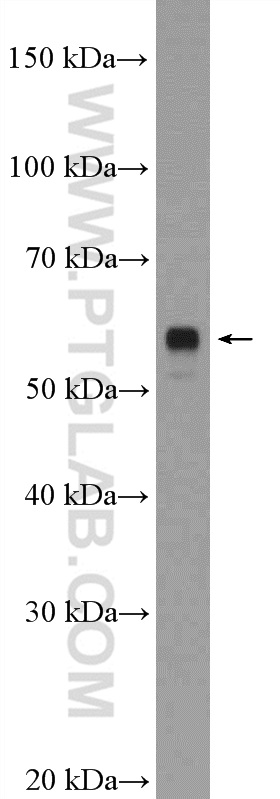验证数据展示
经过测试的应用
| Positive WB detected in | mouse spinal cord tissue |
推荐稀释比
| 应用 | 推荐稀释比 |
|---|---|
| Western Blot (WB) | WB : 1:500-1:1000 |
| It is recommended that this reagent should be titrated in each testing system to obtain optimal results. | |
| Sample-dependent, Check data in validation data gallery. | |
发表文章中的应用
| IP | See 1 publications below |
产品信息
23094-1-AP targets LRRTM2 in WB, IP, ELISA applications and shows reactivity with human, mouse samples.
| 经测试应用 | WB, ELISA Application Description |
| 文献引用应用 | IP |
| 经测试反应性 | human, mouse |
| 文献引用反应性 | human |
| 免疫原 |
CatNo: Ag19422 Product name: Recombinant human LRRTM2 protein Source: e coli.-derived, PGEX-4T Tag: GST Domain: 38-136 aa of BC126408 Sequence: CRCEKLLFYCDSQGFHSVPNATDKGSLGLSLRHNHITELERDQFASFSQLTWLHLDHNQISTVKEDAFQGLYKLKELILSSNKIFYLPNTTFTQLINLQ 种属同源性预测 |
| 宿主/亚型 | Rabbit / IgG |
| 抗体类别 | Polyclonal |
| 产品类型 | Antibody |
| 全称 | leucine rich repeat transmembrane neuronal 2 |
| 别名 | KIAA0416, LRRN2, LRRTM2 |
| 计算分子量 | 516 aa, 59 kDa |
| 观测分子量 | 59 kDa |
| GenBank蛋白编号 | BC126408 |
| 基因名称 | LRRTM2 |
| Gene ID (NCBI) | 26045 |
| RRID | AB_2879209 |
| 偶联类型 | Unconjugated |
| 形式 | Liquid |
| 纯化方式 | Antigen Affinity purified |
| UNIPROT ID | O43300 |
| 储存缓冲液 | PBS with 0.02% sodium azide and 50% glycerol, pH 7.3. |
| 储存条件 | Store at -20°C. Stable for one year after shipment. Aliquoting is unnecessary for -20oC storage. |
背景介绍
Leucine-rich repeat transmembrane proteins (LRRTMs) are synaptic cell adhesion molecules. LRRTMs are highly localized in the postsynaptic density and play various roles in the formation, maturation, and function of synapses (PMID: 25951919). LRRTM2 acts as a post-synaptic ligand of Neurexins. LRRTM2 regulates excitatory synapse development and function in the vertebrate nervous system (PMID: 20064387).
实验方案
| Product Specific Protocols | |
|---|---|
| WB protocol for LRRTM2 antibody 23094-1-AP | Download protocol |
| Standard Protocols | |
|---|---|
| Click here to view our Standard Protocols |


